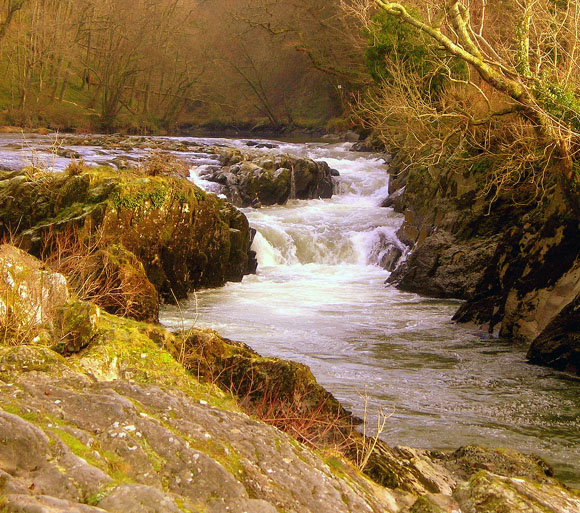The River Teifi (Welsh: Afon Teifi) is a river in West Wales flowing into the sea below Cardigan town. The catchment of the river is estimated to be 1,008 square kilometres yielding an average flow at Glan Teifi of 31.026 m�/s. The maximum recorded flow (up till 1970 ) was 269.7 m�/s on December 17, 1965. The average rainfall varies from 1552 mm in the upper catchment to 1176 mm in the lower catchment.
Geography
The Teifi has its source in Llyn Teifi, one of several lakes known collectively as Teifi Pools. These are situated in mid Wales toward the north of the administrative area of Ceredigion. This wide area, with a very sparse population, is part of the desert of Wales. The river flows past Strata Florida Abbey and then through Pontrhydfendigaid before reaching the main river valley floor. Here it passes through one of the great raised mires of Britain, Gors Goch Glan Teifi, also known as Tregaron Bog. Over the next 30 miles the Teifi meanders generally south-west in a gentle arc, passing through the villages and towns of Tregaron, Llanddewi Brefi, Cwmann, Lampeter, Llanybydder, Llandysul, Newcastle Emlyn, Cenarth, Llechryd and finally Cardigan town. The river becomes tidal below Llechryd and descends into Cardigan town through the steep sided Cilgerran Gorge. Below Cardigan town the river broadens into a wide estuary, passing the seaside resort of Poppit Sands before finally entering the sea in Cardigan Bay
Geology and landscape
The Teifi and its tributaries are underlain by ancient Ordovician and Silurians mudstones which have been extensively glaciated during the ice ages. The resultant landform is one of gently rolling hills supporting a range of agriculture in which dairying and sheep rearing dominate. Cardiganshire (now Ceredigion) had the reputation of supplying London with its milk in the 19th century . The landscapes of the Teifi valley are very attractive and the Teifi is considered by many to be one of the most beautiful rivers in Wales.
Teifi pools, the source of the Teifi are a series of small lakes left by past glacial activity. The lakes are upland and acid in nature. Some have been enlarged by damming and now provide a source of drinking water. The very extensive raised mire above Tregaron acts as a huge sponge at the head of the river evening out extremes in flow. Rapids and waterfalls are uncommon but the examples at Henllan and especially at Cenarth are noteworthy and have been extensively photographed and painted because of the beauty of the landscape. The gorge between Llechryd and Cilgerran has a special brooding quality. Few visitors stray into the gorge and the river winds its way almost silently between the densely wooded sides with their distinctive under-storey flora of sedges.
Culture and history
The Teifi valley has been inhabited since pre-history. There are many remains of Iron Age and Stone age man including Cromlechs ( burial chambers) and standing stones. The remains of a medieval abbey stand at Strata Florida with some excellent examples of encaustic tiles on the floors. The river flows near to the University of Wales, Lampeter which was the oldest university established in Wales and only preceded in Britain by the Universities of Oxford and Cambridge. Between Cenarth and Cardigan there is an ancient tradition of fishing and travel using coracles � very simple light-weight boats made of bent sticks covered with waterproofed hide or skins,. These are paddled by a single oar used at the front of the craft which requires great skill. The principal use for Coracles is in salmon fishing using nets. This form of fishing is now very tightly controlled and the right to fish in this way is passed down from father to son. There is also an age-old tradition of illegal salmon and sea-trout fishing in the lower Teifi. |

